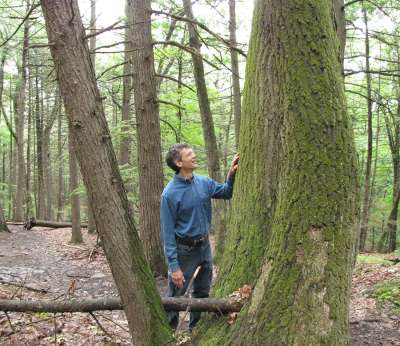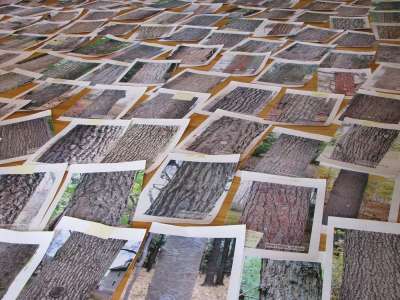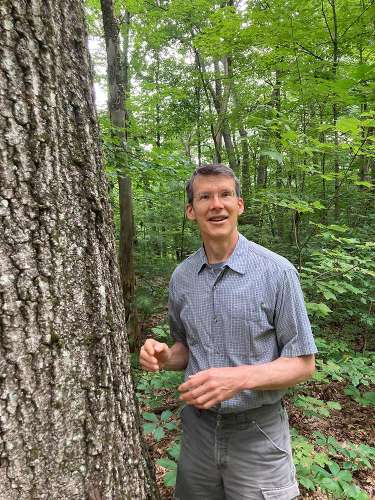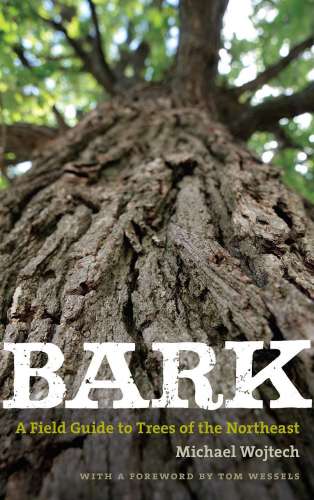
Michael Wojtech remembers being enthralled by the natural world from a young age. But it wasn’t until well into adulthood that he became fascinated, in particular, by trees. A decade after the publication of his book Bark: A Field Guide to the Trees of the Northeast, Michael continues to study trees, and to find both solace and inspiration in the forest, especially near his home in western Massachusetts.
It feels like the urge and the yearning for the outdoors has always there for me. I believe that is there for all of us. Until I was about 10 or 11 years old, we lived in heavy suburban northern New Jersey. Then we moved to the pine barrens, and I had woods right out my door. I spent a lot of time in those woods. At that time, the pine barrens were in the process of the transformation of more buildings and development that is happening everywhere. But a lot of the pine barrens is preserved, and there is kind of a graduated development scheme to allow the core to be completely undeveloped. It’s an interesting place.
My father was always connected to the outdoors, and I think that influenced me as well. He grew up working on his aunt and uncle’s farm, raising chickens, hunting, being out in the woods. He ran a trapping line before school. It was different than my contemplative time in the woods, because it had a more defined purpose or outcome. I did a little bit of hunting as a kid. I trained a dog to point birds, and I raised quail. I never really locked into it, and I didn’t succeed at harvesting game. But I loved being outside.
I moved to New England from New Jersey about 22 years ago. It feels like I’ve been here forever. I live kind of on the edge of Northampton, Massachusetts, right on the edge of what we call the Hill Towns. The Mill River is right down below. I can see the bike path entering the woods. There are plenty of opportunities to get into the forest. Even if I’ve been working all day, I can get out and do a quick little hike or ski. I go walking at night too. I sometimes feel like I can’t breathe if I don’t have my outside time.
I was determined to study forestry or wildlife biology in college, and I went to Virginia Tech for a short time. For a lot of reasons, I ended up coming back home and ended up with a business degree. I got involved in a family business and eventually bought the business with my brothers. I worked in the business for 15 years and burned myself out. I just knew that wasn’t the pace that I wanted to live my life at.
I serendipitously saw a car with a sticker in the back window that said, “Antioch New England Environmental Studies.” I looked it up and found Antioch in Keene, New Hampshire, and learned that I could study conservation biology in a way that fits my desire to be a naturalist and a writer. At one point I wanted to be both a quantitative scientist and a writer, but I kind of chose a lane.
When I went back to school, I expected to focus more on mammals or maybe entomology. I came in to Antioch head over heels with the fact that the school had a wolf ecology field study trip. I visited Antioch three years before I was actually able to get there. I met Tom Wessels, who was then running what was the Environmental Biology program, before Conservation Biology had been mainstreamed as a term. I remember saying to Tom, “I don’t know what I want to study. I want everything. I wanted to be a generalist.” And Tom said, “We need more generalists who can synthesize everything together.”
I think I still am a raging generalist. But I do love the levels of detail that I can fall into with trees. There are so many layers. I love the depth of scale. Trees have that scale of minutiae – dissect a bud and you find all the leaves in there already. And you can go to scales in time, too – that bud grew last summer, that red oak acorn was a flower two years ago. I look at a tree and it’s almost like I can feel that process happening over time. Even with bark – you can look up the trunk and see the young bark, and the old bark is down at the bottom. There’s such a breadth of observations. There’s too much here to be distracted elsewhere.

When I finally had to pick a thesis topic, I thought I would do a guide to winter buds. I could draw them and it would be wonderful. Tom’s advice was that there were already a lot of good guides out there for winter buds. He said that one thing he had on his book list and didn’t think he would ever get to is bark. He thought it could be treated more thoroughly, and that perhaps I could even come up with a key for identifying trees by their bark. I hadn’t given bark a second thought. It’s one of those things where I’m glad I didn’t know quite how much work it would be. I don’t begrudge any of the work, because my job was to go out and wander around and look at trees. It was pretty sweet. But I may have been dissuaded if I had understood the complexity of it.
The first thing I had to do is decide what is a tree. I looked at a lot of different definitions and decided that trees are woody plants that grow 30 feet or taller. Even at that, I ended up with more than 60 native or naturalized species that fit that definition in New England and eastern New York state. That’s a lot of species. And most species have at least two, if not more, incarnations of bark, which means each species had to be in the key multiple times. I think sugar maple has more entries in the key than any other tree, because it’s almost indescribably different all the time.
The initial part of the book – writing the key – was my thesis. It’s a big responsibility – to think, “Have I communicated effectively, and am I leaving people frustrated?” It’s intimidating to try to look at something when you don’t even know where to start. When you’re looking at something new, you don’t even know where to start, and I think we normally kind of bounce off of something when we don’t know where to get in. I felt so responsible for not having somebody bounce off. I wrote the key, and then I got to field test it with Tom a few times, then fix the things that he had questions about. For me, when Tom felt that it worked, that was such a gift. Otherwise, I would be still revising. The book was published 7½ years after I started working on it.
With bark, when I got to the point when I could tell different types apart, all of a sudden, I walked into the back yard, and I realized there were six or seven species right there. I couldn’t necessarily name them, but I could tell that the bark was different. That was the big first step. Hopefully I never lose the ability to remember what it was like to not have any idea what any of it was. It’s almost like a sense of wonder that I’m trying to introduce. I don’t care if you know the names of the trees, but if you’re out there noticing, that’s fabulous.
I do educational programs for different organizations and enjoy that opportunity. Writing is a solitary endeavor, and I like that part of it, but it’s really fun to share enthusiasm. I get inspired, and I learn. I get to make mistakes sometimes, which I think is really helpful. I had one instance during a workshop I was leading where we were walking along a trail, and there was a field on one side, and at the edge of the field was a bank of trees. I looked at the bark, and there were these big, long strips of bark curling out on the ends. I said to the group, “Isn’t in wonderful that you can look across this field and see that that’s a shagbark hickory?” And then we walked up to the tree, and it was a rogue red maple! I’m OK with making mistakes, and I’m actually glad when that happens, because maybe then people aren’t so hard on themselves. It can be confusing sometimes.
I’ve been, little by little, accumulating information about how trees grow. I’ve done some teaching on that and workshops. I’d love to put another book out, and I think I will get that together at some point. I wouldn’t dare put a timetable on it yet. But I’m writing about that growth process and how trees function. I think it still comes around to being able to look at trees in that perspective sense – doing the accordion flex of spatial scale and time scale.
Isn’t it nice that nature is so diverse and wonderful that we’ll never know everything? There’s always something else. I’m happy that there’s always more out there. You answer one question, and that opens up five new questions.



